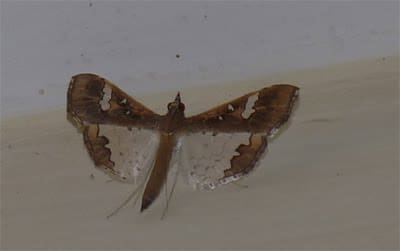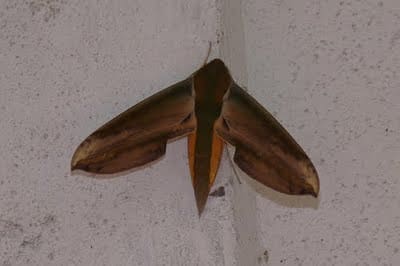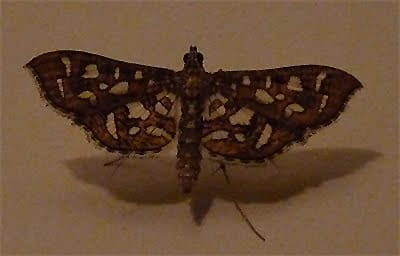Over the last three weeks, the weather has been very odd in Bangalore. We had an extended spell of rain and some very wet days. And then some very warm nights — sleeping with the fan on at night in late November has certainly been a first. It’s been such unusual weather that even my grandmother has been talking of climate change.
The good thing, however, is that we had lots of toads visiting us to partake of the feast of flying termites — three or four biggish fellows and a hailstorm of really tiny ones that made me all queasy at the thought that I might accidentally trample them underfoot. Apart from that, fluorescent lighting attracted at least three interesting nocturnal visitors to the lobby of our apartment — gorgeous moths that beg to be identified.
Here they are. If you know their names, please do let me know who they are.

Tiny — about 2 cm across

Largish — about 8 cm across

Tiny — about 2 cm across
- TL;DR – Death Stalks Like A Marabou Stork - July 24, 2024
- Dimorphic Egret – Meet this East African mystery bird - June 8, 2024
- Encounter: Northern Treeshrew in Arunachal Pradesh - May 19, 2024

I think there's something kind of wonderful about something that is common in one place, or even a pest and yet at exactly the same time, in another part of the world, an exciting find for someone else. Nature has a way of keeping us on our toes.
All the best. Magz
Thank you, Magz, for the insight on the moths. The first and last are quite common where I live.
Anonymous again (UK) – The first moth is a Mung Moth – Maruca vitrata – (Fabricius, 1787)- Wingspan 28-34 mm.
In the United Kingdon its a very rare vagrant or adventive species, possibly imported from the Tropics in leguminous vegetables. Abroad, it is a pest of these types of plant, where the larvae bore into the pods.
Hope that helps!
Magz
So did anyone identify the first moth? We found one in the kitchen in England, so it seems they can certainly spread their wings!
This comment has been removed by the author.
thanks for sharing this article, it's and of course Thanks to Jonathan Balcombe for sharing his knowledge about the unknown moths.
I have always been a fan of flying objects such as birds, butterflies and the like, and it makes me happy every time I encounter new species and names. this will go to my list.
Dear Dr Balcombe,
I'm honored to have you visit. Thank you for the praise for my blog and your tip to identify the moth.
Your blog and website are fascinating, and so are the subjects of your research. Are your books available in India?
Where have you traveled in India?
best,
Bijoy
Your blog is terrific. I have traveled in India and I always write about my travel experiences, many of which involve animals as I am a biologist/ethologist, birdwatcher, insectwatcher, etc.
Pretty sure the 2nd moth is a sphynx moth, a member of the large Sphyngidae family.
Jonathan Balcombe, PhD
Germantown, MD
USA
http://www.pleasurablekingdom.com
http://www.jonathanbalcombe.com
Forthcoming: Second Nature: The Inner Lives of Animals (Palgrave Macmillan, March 2010)
Forthcoming: Exultant Ark: A Pictorial Tour of Animal Pleasure (Univ of California Press, Sept 2010)